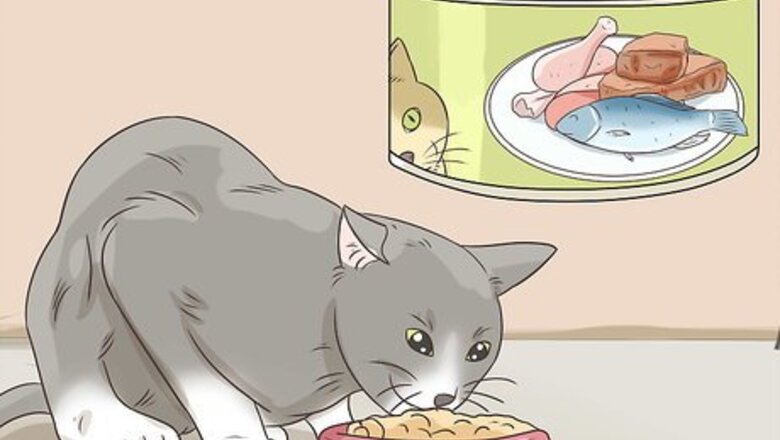
views
Selecting Food for a Diabetic Cat
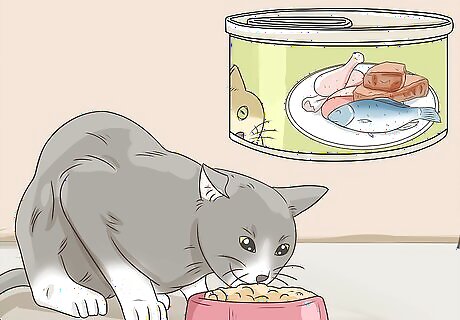
Feed your cat wet food to increase their protein intake. High protein is an important dietary factor for cats with diabetes. Look for food that contains high quality protein sources like chicken, fish, or beef. Canned food can be fed to increase your cat’s protein intake and decrease their carbohydrate intake. Diabetic cats with kidney disease may negatively react to a high protein diet, so talk to your veterinarian before switching your cat’s food. Cats with diabetes can become dehydrated easily, so choosing canned wet food for your cat also helps ensure they get the water they need at each meal.
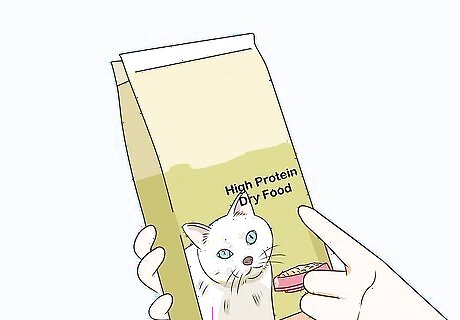
Choose a high protein dry food if your cat won’t eat wet food. Dry foods that are high in protein and/or fiber can be fed to cats that are picky and will only eat dry food. Talk to your veterinarian before switching your cat’s food. Be sure your cat has access to fresh, clean water at all times.
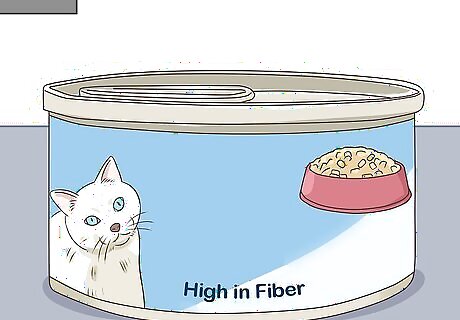
Select food high in fiber. Cats with diabetes may need food high in fiber so they can better absorb glucose and fat in their diet. High fiber diets are also good for weight loss, which is ideal if your cat is overweight or obese. Read the label of the cat food and check the nutritional values listed. Make sure the canned food contains at least 50% animal based protein.
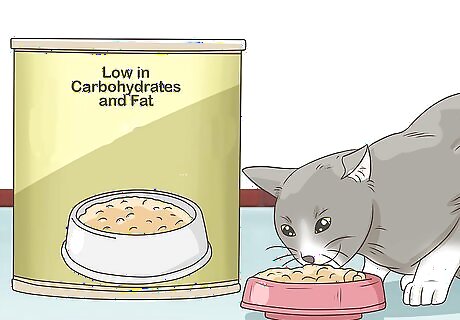
Pick food that is low in carbohydrates and fat. Make sure your cat is getting at least 20-45 percent of its daily calorie intake from fat and only 1-2 percent of its daily calorie intake from carbohydrates. Having a low carbohydrate diet will help your cat regulate its symptoms. Look for wet cat food where less than 10 percent of the calories are coming from carbohydrates. It can be tricky to find information about the carbohydrates and fat content in cat food on the label. You can contact pet food companies to find out this information or ask your vet if certain cat food brands are known to be good for diabetic cats.
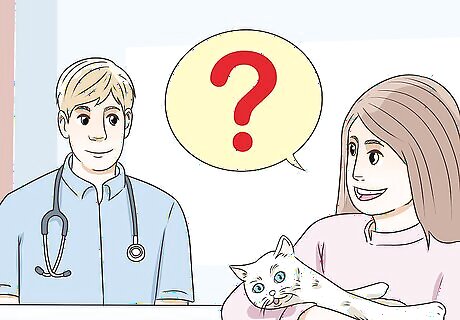
Ask your vet for food recommendations. Before you change your cat’s diet, consult with your vet. Ask them for recommendations on cat food brands that are ideal for diabetic cats. Your vet should be able to suggest several cat food options for your pet. Based on your cat’s condition, your vet may recommend a prescription diabetic food for your cat. These prescription foods are designed for diabetic cats but they can be expensive.
Creating a Feeding Schedule
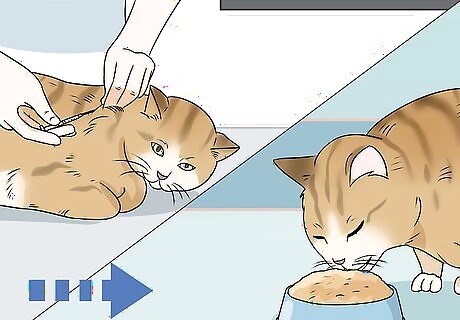
Give your cat insulin right after feeding it. Doing this will ensure the insulin is absorbed properly and that the cat does not have low blood sugar. Get in the habit of giving your cat insulin right after its scheduled feeding time. Your vet should show you how to give your cat their insulin. You may need to practice doing this a few times to get it right.
Transition your cat to its new food gradually. Do this by adding a small amount of the new food to its old food. Increase the amount over time so your cat gets used to the new food. For example, you may give your cat ¼ of its old food and ¼ of a can of high protein, low carbohydrate food to start. Over a week to two weeks, you can increase the amount of new food in your cat’s diet. Make sure your cat eats the mix of old and new food. Not eating can be dangerous for diabetic cats. If your cat does not seem interested in its food, you may need to revert back to its old diet for a little while to get it to eat again and transition it to the new food more slowly. Do not let your cat eat human food or table scraps, as this can negatively affect its condition.
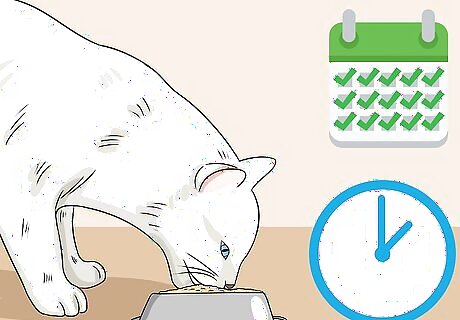
Stick to regular feeding times. It is very important that a diabetic cat has a strict and regular feeding schedule. Feed your cat twice a day at the same times. If your cat usually likes to graze or snack throughout the day, try to get it to eat at set times instead. For example, you may feed your cat once in the morning before you go to work and once at night before bed.
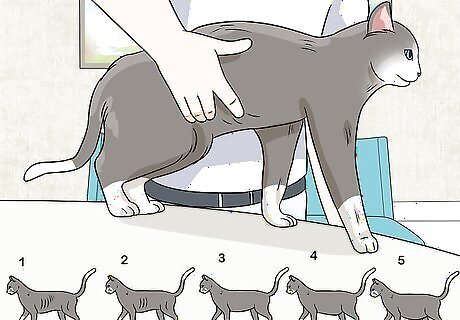
Determine your cat’s body condition score. A body condition score tells you whether your cat’s size and weight are under the ideal, ideal, or over the ideal. Look at your cat from the side and from the top to determine its score. If your cat is over or under ideal, speak with your veterinarian about adjusting their diet. An under ideal cat has visible ribs, no palpable fat, and a pronounced abdominal tuck. An ideal cat is well-proportioned, with a slight abdominal tuck and a minimal abdominal fat pad. An over ideal cat has a poorly visible waist, rounding of the abdomen, and fat deposits present.
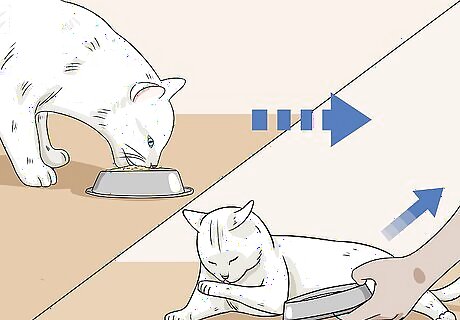
Reduce your cat’s portions if it is overweight. Many diabetic cats are overweight or obese. If this is the case with your diabetic cat, you should reduce its portions so it can lose weight and stay healthy. Ask your vet to recommend portion sizes for your obese cat. Your cat should be given reduced portions until it hits a healthy body weight. Do not leave your cat's food out throughout the day to let it graze or snack on. This can lead to weight gain. Instead, only put your cat's food out when it is feeding time. You can also help your obese cat stay healthy by giving it access to climbing and resting areas in your home so it can roam around. Have play time with the cat regularly so it gets enough exercise every day.
Maintaining Your Cat’s Condition
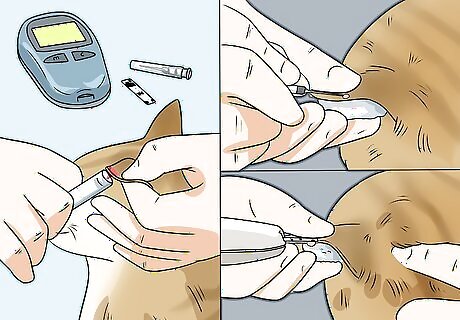
Check your cat’s blood sugar regularly. Diabetic cats should have their blood sugar levels checked regularly to ensure they are not experiencing low blood sugar or other issues. Ask your vet to recommend a blood sugar level monitor that you can use on your cat. You will need to use the monitor to test your cat’s blood for any issues or abnormalities.
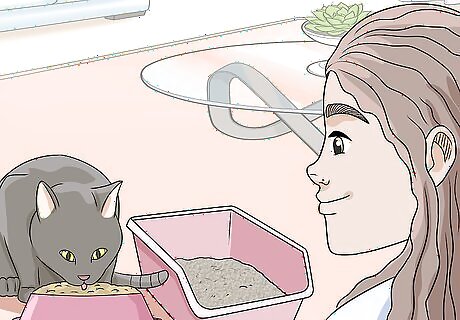
Monitor your cat’s appetite, weight, and litter box. Check that your cat eats all of its food at every meal. If it is not eating, you may need to switch the cat back to its old food for awhile or speak to your vet. You should also monitor your cat’s weight using a scale to make sure it is not overweight or gaining more weight than it should. You should also check your cat’s litter box to confirm it is going to the bathroom regularly. It should be urinating the same amount of liquid on a regular schedule. If this is not the case, speak to your vet.
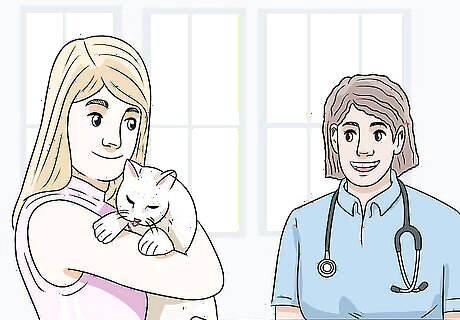
Bring your cat to the vet for regular check ups. Schedule monthly or semi annual check ups with your vet to monitor your cat’s condition. Your vet can help you stay on top of your cat’s feeding schedule and diet. They can also let you know if your cat’s diabetes is improving or if you need to make adjustments so your cat’s condition does not get worse. Keep in mind with the right diet, some cats can go into diabetic remission, where they no longer have low insulin levels. Over time you may be able to reduce the amount of insulin you give your cat or not need to give them insulin at all. If this happens, you will still need to maintain your cat’s diet and health to ensure the diabetes does not return.




















Comments
0 comment